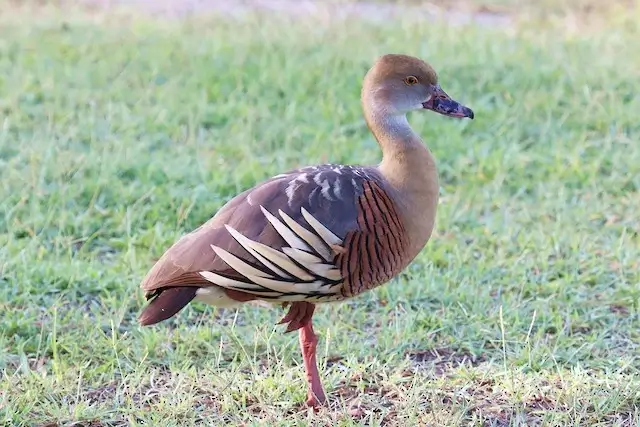Plumed Whistling Duck

Scientific Name
Dendrocygna eytoni
Alternative Names
Grass Whistling Duck, Eyton’s Plumed Tree-Duck, Red-legged Whistler
Measurements:
| Feature | Male | Female |
|---|---|---|
| Length | 42–60 cm (16.5–23.5 in) | 42–60 cm (16.5–23.5 in) |
| Weight | Around 1 kg (2.2 lb) | Around 1 kg (2.2 lb) |
| Wingspan | Short, rounded wings (exact measurement not widely recorded) | Same as male |
Status
Common in many parts of Australia and not currently considered endangered.
Identification
This duck has a long neck, brown upper body, pale underside, and a white rump. It is easy to recognize by the long, curved plumes that stand out from its sides. The chest is chestnut with fine black bars. Both the bill and legs are pink, and the eyes are yellow. Males and females look the same.
Voice
It makes a soft, high-pitched whistling call, which is how it got its name.
Diet
Unlike many ducks, it rarely feeds in water. Instead, it grazes on land, eating grasses and seeds.
Distribution
Found across northern, eastern, and central Australia—from the Kimberley region, across the Top End, down through Queensland and into northern New South Wales. It also lives in parts of New Guinea.
Habitat
Prefers open grasslands, savannas, and farmland, often close to water sources like wetlands, rivers, or dams.
Breeding
Breeds mainly in the wet season (January to March). It lays 10–12 creamy eggs in a simple nest made of grasses, usually hidden in tall vegetation. Both parents help care for the eggs, which take about 30 days to hatch.
Wintering
The species does not migrate long distances. Instead, it moves locally in search of food and water during dry periods.
Conservation
Currently stable, but depends on healthy grasslands and wetlands. Protection of natural habitat helps maintain its population.
